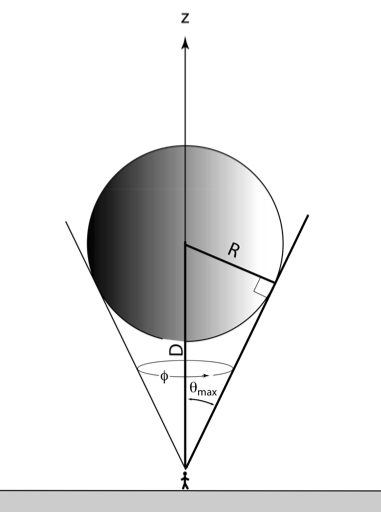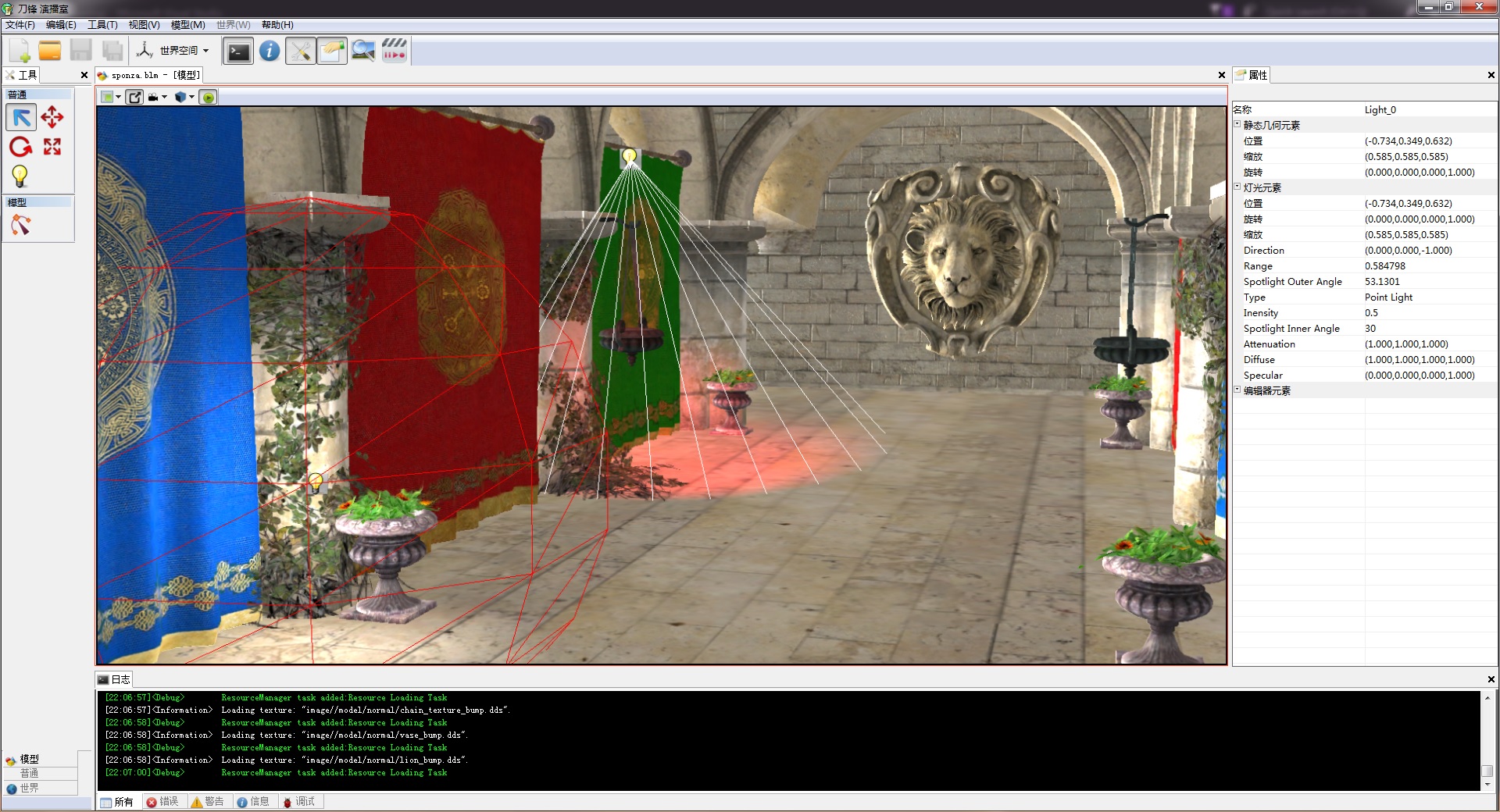引擎设计跟踪(九.14.3.2) Deferred shading的后续实现和优化
2016-03-30 10:56
363 查看
最近完成了deferred shading和spot light的支持, 并作了一部分优化.
之前forward shading也只支持方向光, 现在也支持了点光源和探照光. 对于forward shading, 可以在渲染每个对象之前, 用对象的包围盒, 查询空间内的光源, 然后填入shader cosntant里. 因为空间一般是基于四叉树或者八叉树的划分, 所以查询不会慢.现在透明物体也能通过forward shading 正常光照了。
Deferred shading optimizations
1. Early Z & Early Stencil
http://amd-dev.wpengine.netdna-cdn.com/wordpress/media/2012/10/Deferred%20Shading%20Optimizations.pps
上面的文章介绍了deferred shading的一些细节和优化方式, 其中提到了Early Z和early stencil.
对于early z来说, 只能裁掉一半的无效几何数据.如果是less/less qual, 那么光照范围后面的区域也会计算, 如果是greater/greater qual, 光照范围之前的区域也会参与lighting 计算(冗余计算,并没有效果).
early stencil的话需要把light volume加上stencil pass. 本来也打算使用stencil来优化, 过滤掉无效的区域.
后面看到这篇文章:
https://software.intel.com/en-us/articles/deferred-rendering-for-current-and-future-rendering-pipelines
上面提到了几点, 其中提道stencil 写入的开销太大, 并不高效. 该文章的demo中使用的是early z.
2.Z culling in shader
由于上面使用了earlyz, 所以光照区域平均大概有一半无效的计算.
如果在shader里面根据深度,把另一半的无效区域做early out, 理论上效率会更好.
为了验证我的想法, 在上面intel的那个demo里面加上了几行简单的代码:
代码修改并不多: vertex shader里面计算view space z, 因为demo 使用了less equal, 所以需要加上额外的max z, 相当于shader里面手动做greater过滤(类似Depth Bounds Test).
最后的结果, 在730M上测试, 使用这种方式效率提高50%-100%,当灯光个数比较多的时候,deferred shading的效率会翻倍!, 当然比起tiled方法毕竟还是too young, 因为多个光源光照范围重合的部分, 仍然需要sampling和blending多次.
all shader compild with flag D3DCOMPILE_OPTIMIZATION_LEVEL3
从上面可以看出, shader里使用zculling以后, 128盏灯光以前, deferred shading和tiled方式的性能差别不大 (如果是更低端的GPU, 可能会有差别, 而且要注意tile based方式并没有做任何优化).
分析: 因为shader里面做深度比较时, 只需要采样depth buffer, 如果不在范围内, 直接clip & return, 所以后面的采样和计算以及混合都不需要了.
顺便记录一下clip, 默认shader不开优化的时候, clip只是取消的像素blend到back buffer, shader还是会继续执行的, 除非手动添加上return,或者开启优化(D3DCOMPILE_OPTIMIZATION_LEVEL3).
而动态分支和clip对于SM3.0+以上都是更好的方式, 至少现有文档里面DX10及以上的API都是鼓励使用clip和分支, 来减少shader计算量.
如果不使用clip, 而是返回float4(0,0,0,0)虽然显示结果一样,但是效率会降低,因为还是要blend到backbuffer.
而旧的GPU, clip和branch反而可能导致shader divergence, 所以clip有可能只通知discard掉当前fragment, shader还是会照样执行.
还需要注意的是, 如果开启了depth write, clip会导致early Z 失效(这算是常识,原因不用备忘). 而在deferred shading这里, shading pass不会写深度, 所以没有问题.
对应blade的实现, 因为使用了INTZ, 而INTZ在某些A卡上, 如果同是作为纹理采样, 并用作depth stencil做深度测试时会有效率损失(http://aras-p.info/texts/D3D9GPUHacks.html),
需要blit出另外一个zbuffer分别使用, 反而更麻烦, 所以blade不使用early z(关闭深度测试), 直接在shader里面做两个depth clip并early out:
vertex shader:
pixel shader:
代码跟上面的修改类似, 在vertex shader里面根据view space的bounding, 计算light volume 的zmin和zmax, 在pixel shader里面做剔除。
需要注意, 尽量使用view space的李linear depth来比较,因为直接比较zbuffer depth的话, 误差会比较大. 如果加上误差容许, 那么远处的depth因为精度低的原因, 会导致没有被clip掉, 也就是说因为zbuffer的深度是非线性的,所以误差根距离相关并不好控制.
做完基于depth的clip之后, 还可以基于光照属性,比如light 的范围, spot light的angle来clip, 这样只会有少量的计算(ray计算position,然后计算是否受光照), 如果不在范围内就clip掉,避免后面的color/normal采样和光照计算。 而比较时需要用的这些参数计算, 因为计算光照也需要, 所以并不浪费。
3. Quad vs volume
intel的pdf中也提到, 使用quad效率要比使用light volume效率高, light volume顶点多有点浪费. 所以blade也改成quad绘制, 用scrren space的full screen quad做vertex buffer, vertex shader里面做scale+offset. light helper依然使用volume来显示, 这样看起来比较直观方便。
这里记录一些小的细节:
不管是用light volume还是quad, 都可能会有极少部分没有计算光照:
即便使用light volume(sphere), 两个view ray也不能完全覆盖前面部分的半球, 会有极少部分遗漏,偶尔会发现光照突然消失的竖块。如果使用back plane(further plane)问题更严重。
更新: light volume会覆盖切线, 切线内的范围是光照的最大范围, 所以范围够了. 唯一的两个问题是mesh精度导致没有到切线; 以及过了切线的部分有重复shading

intel的那个实现使用的是front plane+depth less的深度测试。front plane投影的面积虽然大, 可以覆盖全部volume,但是在视锥外的时候,会被设备clip掉(1或者-1之外),导致计算光照错误:
仍然有部分光照没有计算。
blade的解决方法是: 使用back plane并放大,放大到和front plane投影面积一样大。scale可以根据深度参数计算,而深度在前面需要depth clip的时候后正好已经计算过了, 所以成本很低:
这样就可以把(-1,-1),(-1,1),(1,1),(1,-1)的full screen quad计算到屏幕上覆盖light范围的quad。
还有需要注意的是vertex shader中计算出的ray不能normalize, 之前在方向光的时候normalize不影响,因为投影到全屏是等距离的,ray的长度必定相等,不影响GPU插值,没有出现问题;light volume因为顶点比较多所以插值误差比较小;现在quad只有四个顶点,非方向光的话,quad的位置在屏幕并不对称,两个ray的长度通常不相等, normalize之后插值的结果方向不对。
4. Light quad merging
如果使用了quad来lighting, 那么也很方便在screen space合并灯光的quad, 这样理论上可以分割,合并所有重合区域, 在合并的区域内迭代计算每个光源, 最终效果是, Gbuffer只采样一次, blending也没有重复, 这样的效率应该不比tile based 方法低,
不过这一点目前只是简单探讨和感想, 具体怎么分割和合并还没有具体去想。
5.Tile based deferred shading
这个是现在比较高效的方法, 还有一个cluster的方法,比这个方法更复杂,效率更高一点。原理都很类似, 划分区域并减少重复的sampling和blending,解决deferred方式的IO瓶颈。
目前正在考虑是否要在SM3.0上实现tiled方法, 这里有个龚大大的文章, 值得参考:
http://www.klayge.org/2013/12/02/klayge-4-4%E4%B8%AD%E6%B8%B2%E6%9F%93%E7%9A%84%E6%94%B9%E8%BF%9B%EF%BC%88%E4%B8%80%EF%BC%89%EF%BC%9A%E5%8F%AA%E9%9C%80%E8%A6%81sm3%E7%9A%84tbdr/
根据tile based原理,可以做出很多具体实现和变种,龚敏敏大大的实现就是一种,我也想了一种实现,效率不一定比他的高,但是记下来以便以后尝试:
在CPU端计算screen space下每个光源对每个tile的影响, (忽略tiled方法中每个tile的深度), 生成一张每个tile的光源索引的texture, 然后再pixel shader里面索引光照并计算.
这种方式可以支持任意多的光源, 并不需要多个批次, 但是culling变成per pixel的, 所以比常规tile based方式效率要低, 但是仍在tile里迭代计算, 因为没有多次sampling和blending, 效率应该比deferred shading高, 后面有时间的话会尝试一下, 待议。因为128盏灯光一般来说游戏已经够用了,这个时候deffered shading效率可以接受。如果硬件配置比较低,或者灯光数量太多时用再考虑。
最后还是传统,发截图留念

之前forward shading也只支持方向光, 现在也支持了点光源和探照光. 对于forward shading, 可以在渲染每个对象之前, 用对象的包围盒, 查询空间内的光源, 然后填入shader cosntant里. 因为空间一般是基于四叉树或者八叉树的划分, 所以查询不会慢.现在透明物体也能通过forward shading 正常光照了。
Deferred shading optimizations
1. Early Z & Early Stencil
http://amd-dev.wpengine.netdna-cdn.com/wordpress/media/2012/10/Deferred%20Shading%20Optimizations.pps
上面的文章介绍了deferred shading的一些细节和优化方式, 其中提到了Early Z和early stencil.
对于early z来说, 只能裁掉一半的无效几何数据.如果是less/less qual, 那么光照范围后面的区域也会计算, 如果是greater/greater qual, 光照范围之前的区域也会参与lighting 计算(冗余计算,并没有效果).
early stencil的话需要把light volume加上stencil pass. 本来也打算使用stencil来优化, 过滤掉无效的区域.
后面看到这篇文章:
https://software.intel.com/en-us/articles/deferred-rendering-for-current-and-future-rendering-pipelines
上面提到了几点, 其中提道stencil 写入的开销太大, 并不高效. 该文章的demo中使用的是early z.
2.Z culling in shader
由于上面使用了earlyz, 所以光照区域平均大概有一半无效的计算.
如果在shader里面根据深度,把另一半的无效区域做early out, 理论上效率会更好.
为了验证我的想法, 在上面intel的那个demo里面加上了几行简单的代码:
// One per quad - gets expanded in the geometry shader
struct GPUQuadVSOut
{
float4 coords : coords; // [min.xy, max.xy] in clip space
float quadZ : quadZ;
//Crazii
float quadMaxZ : quadMaxZ;
//-//Crazii
uint lightIndex : lightIndex;
};
GPUQuadVSOut GPUQuadVS(uint lightIndex : SV_VertexID)
{
GPUQuadVSOut output;
output.lightIndex = lightIndex;
// Work out tight clip-space rectangle
PointLight light = gLight[lightIndex];
output.coords = ComputeClipRegion(light.positionView, light.attenuationEnd);
// Work out nearest depth for quad Z
// Clamp to near plane in case this light intersects the near plane... don't want our quad to be clipped
float quadDepth = max(mCameraNearFar.x, light.positionView.z - light.attenuationEnd);
// Project quad depth into clip space
float4 quadClip = mul(float4(0.0f, 0.0f, quadDepth, 1.0f), mCameraProj);
output.quadZ = quadClip.z / quadClip.w;
//Crazii
//quadClip = mul(float4(0.0f, 0.0f, light.positionView.z + light.attenuationEnd, 1.0f), mCameraProj);
//output.quadMaxZ = quadClip.z / quadClip.w;
output.quadMaxZ = light.positionView.z + light.attenuationEnd;
//-Crazii
return output;
}
struct GPUQuadGSOut
{
float4 positionViewport : SV_Position;
// NOTE: Using a uint4 to work around a compiler bug. Otherwise the SV_SampleIndex input to the per-sample
// shader below gets put into a '.y' which doesn't appear to work on some implementations.
nointerpolation uint4 lightIndex : lightIndex;
//Crazii
nointerpolation float maxDepth : maxDpeth;
//-Crazii
};
// Takes point output and converts into screen-space quads
[maxvertexcount(4)]
void GPUQuadGS(point GPUQuadVSOut input[1], inout TriangleStream<GPUQuadGSOut> quadStream)
{
GPUQuadGSOut output;
output.lightIndex = input[0].lightIndex;
//Crazii
output.maxDepth = input[0].quadMaxZ;
//-Crazii
output.positionViewport.zw = float2(input[0].quadZ, 1.0f);
// Branch around empty regions (i.e. light entirely offscreen)
if (all(input[0].coords.xy < input[0].coords.zw)) {
output.positionViewport.xy = input[0].coords.xw; // [-1, 1]
quadStream.Append(output);
output.positionViewport.xy = input[0].coords.zw; // [ 1, 1]
quadStream.Append(output);
output.positionViewport.xy = input[0].coords.xy; // [-1, -1]
quadStream.Append(output);
output.positionViewport.xy = input[0].coords.zy; // [ 1, -1]
quadStream.Append(output);
quadStream.RestartStrip();
}
}
float4 GPUQuad(GPUQuadGSOut input, uint sampleIndex)
{
float3 lit = float3(0.0f, 0.0f, 0.0f);
[branch] if (mUI.visualizeLightCount) {
lit = rcp(255.0f).xxx;
} else {
//Crazii
float zBuffer = gGBufferTextures[3].Load(input.positionViewport.xy, sampleIndex).x;
float viewSpaceZ = mCameraProj._43 / (zBuffer - mCameraProj._33);
if (viewSpaceZ - input.maxDepth > 0)
clip(-1);
//-Crazii
SurfaceData surface = ComputeSurfaceDataFromGBufferSample(uint2(input.positionViewport.xy), sampleIndex);
// Avoid shading skybox/background pixels
// NOTE: Compiler doesn't quite seem to move all the unrelated surface computations inside here
// We could force it to by restructuring the code a bit, but the "all skybox" case isn't useful for
// our benchmarking anyways.
if (surface.positionView.z < mCameraNearFar.y) {
PointLight light = gLight[input.lightIndex.x];
AccumulateBRDF(surface, light, lit /*Crazii*/, true /*-Crazii*/);
}
}
return float4(lit, 1.0f);
}代码修改并不多: vertex shader里面计算view space z, 因为demo 使用了less equal, 所以需要加上额外的max z, 相当于shader里面手动做greater过滤(类似Depth Bounds Test).
最后的结果, 在730M上测试, 使用这种方式效率提高50%-100%,当灯光个数比较多的时候,deferred shading的效率会翻倍!, 当然比起tiled方法毕竟还是too young, 因为多个光源光照范围重合的部分, 仍然需要sampling和blending多次.
| GT 730M, 1280x720, scene: power plant | 64 Lights | 128 Lights | 256 Lights | 512 Lights | 1024 Lights |
| Tile based deferred shading | 188.5 FPS | 180.9 FPS | 160.6 FPS | 136.2 FPS | 106.8 FPS |
| Deferred shading | 169.5 FPS | 117 FPS | 56.9 FPS | 31.8 FPS | 17.16 FPS |
| Deferred shading + shader depth clip | 209 FPS | 170 FPS | 107.5 FPS | 71.5 FPS | 44.5 FPS |
从上面可以看出, shader里使用zculling以后, 128盏灯光以前, deferred shading和tiled方式的性能差别不大 (如果是更低端的GPU, 可能会有差别, 而且要注意tile based方式并没有做任何优化).
分析: 因为shader里面做深度比较时, 只需要采样depth buffer, 如果不在范围内, 直接clip & return, 所以后面的采样和计算以及混合都不需要了.
顺便记录一下clip, 默认shader不开优化的时候, clip只是取消的像素blend到back buffer, shader还是会继续执行的, 除非手动添加上return,或者开启优化(D3DCOMPILE_OPTIMIZATION_LEVEL3).
而动态分支和clip对于SM3.0+以上都是更好的方式, 至少现有文档里面DX10及以上的API都是鼓励使用clip和分支, 来减少shader计算量.
如果不使用clip, 而是返回float4(0,0,0,0)虽然显示结果一样,但是效率会降低,因为还是要blend到backbuffer.
而旧的GPU, clip和branch反而可能导致shader divergence, 所以clip有可能只通知discard掉当前fragment, shader还是会照样执行.
还需要注意的是, 如果开启了depth write, clip会导致early Z 失效(这算是常识,原因不用备忘). 而在deferred shading这里, shading pass不会写深度, 所以没有问题.
对应blade的实现, 因为使用了INTZ, 而INTZ在某些A卡上, 如果同是作为纹理采样, 并用作depth stencil做深度测试时会有效率损失(http://aras-p.info/texts/D3D9GPUHacks.html),
需要blit出另外一个zbuffer分别使用, 反而更麻烦, 所以blade不使用early z(关闭深度测试), 直接在shader里面做两个depth clip并early out:
vertex shader:
#if !defined(DIRECTIONAL) //use outer sphere to make sure rays covers entire volume # if defined(POINT) float4 posVS = float4(viewSpacePos.xyz, 1); float3 halfSize = viewSpacePos.w; # else float4 posVS = viewSpaceBounding[0]; float3 halfSize = viewSpaceBounding[1].xyz; # endif //view space depth range. note posVS.z < 0 in Right handed system outDethRange = float2(-(posVS.z + halfSize.z), -(posVS.z - halfSize.z)); //min,max ... #endif
pixel shader:
#if !defined(DIRECTIONAL)
//GBuffer depth
float2 depthUV = UV * depthUVSpace.zw + depthUVSpace.xy;
float depth = tex2D(depthBuffer, depthUV).r; //INTZ
depth = depth * depthFactor.z + depthFactor.w; //depth to NDC [0,1] or [-1,1]
float viewDepth = depthFactor.y / (depth + depthFactor.x); //right handed inverse calculation from NDC to viewZ (viewZ < 0, and make it > 0 )
if (viewDepth - depthRange.x < 0 || viewDepth - depthRange.y > 0)
{
clip(-1);
//return float4(0, 0, 0, 0); /optimized level 3(O3) will auto return on clip
}
...
#endif代码跟上面的修改类似, 在vertex shader里面根据view space的bounding, 计算light volume 的zmin和zmax, 在pixel shader里面做剔除。
需要注意, 尽量使用view space的李linear depth来比较,因为直接比较zbuffer depth的话, 误差会比较大. 如果加上误差容许, 那么远处的depth因为精度低的原因, 会导致没有被clip掉, 也就是说因为zbuffer的深度是非线性的,所以误差根距离相关并不好控制.
做完基于depth的clip之后, 还可以基于光照属性,比如light 的范围, spot light的angle来clip, 这样只会有少量的计算(ray计算position,然后计算是否受光照), 如果不在范围内就clip掉,避免后面的color/normal采样和光照计算。 而比较时需要用的这些参数计算, 因为计算光照也需要, 所以并不浪费。
3. Quad vs volume
intel的pdf中也提到, 使用quad效率要比使用light volume效率高, light volume顶点多有点浪费. 所以blade也改成quad绘制, 用scrren space的full screen quad做vertex buffer, vertex shader里面做scale+offset. light helper依然使用volume来显示, 这样看起来比较直观方便。
这里记录一些小的细节:
不管是用light volume还是quad, 都可能会有极少部分没有计算光照:
/* using farther plane: light volume: use farther/center plane causing volume not fully covered (filled in x) +------------------+ |\ /| |x\ /x| |xx\ /xx| |xxx\ /xxx| +----\ /----+ minRay maxRay */
即便使用light volume(sphere), 两个view ray也不能完全覆盖前面部分的半球, 会有极少部分遗漏,偶尔会发现光照突然消失的竖块。如果使用back plane(further plane)问题更严重。
更新: light volume会覆盖切线, 切线内的范围是光照的最大范围, 所以范围够了. 唯一的两个问题是mesh精度导致没有到切线; 以及过了切线的部分有重复shading

intel的那个实现使用的是front plane+depth less的深度测试。front plane投影的面积虽然大, 可以覆盖全部volume,但是在视锥外的时候,会被设备clip掉(1或者-1之外),导致计算光照错误:
/* using nearer(front) plane: +--------------------------+ \ / \ +--/--+ farther plane \ | / | \ |/ | Center \ / | \ /+-----+ nearer plane - clipped! */
仍然有部分光照没有计算。
blade的解决方法是: 使用back plane并放大,放大到和front plane投影面积一样大。scale可以根据深度参数计算,而深度在前面需要depth clip的时候后正好已经计算过了, 所以成本很低:
//screen pos: posVS.z -= halfSize.z; //use farther plane, to avoid near clip (xy outrange[-1,1]) float4 projCenter = mul(posVS, projMatrix); projCenter /= projCenter.w; //farther plane is too small to cover the volume, scale it to the same projection size of nearer plane float scale = outDethRange.y / outDethRange.x; posVS.xy += halfSize.xy*scale; float4 projMax = mul(posVS, projMatrix); projMax /= projMax.w; pos.xy = pos.xy*(projMax.xy - projCenter.xy) + projCenter.xy;
这样就可以把(-1,-1),(-1,1),(1,1),(1,-1)的full screen quad计算到屏幕上覆盖light范围的quad。
还有需要注意的是vertex shader中计算出的ray不能normalize, 之前在方向光的时候normalize不影响,因为投影到全屏是等距离的,ray的长度必定相等,不影响GPU插值,没有出现问题;light volume因为顶点比较多所以插值误差比较小;现在quad只有四个顶点,非方向光的话,quad的位置在屏幕并不对称,两个ray的长度通常不相等, normalize之后插值的结果方向不对。
4. Light quad merging
如果使用了quad来lighting, 那么也很方便在screen space合并灯光的quad, 这样理论上可以分割,合并所有重合区域, 在合并的区域内迭代计算每个光源, 最终效果是, Gbuffer只采样一次, blending也没有重复, 这样的效率应该不比tile based 方法低,
不过这一点目前只是简单探讨和感想, 具体怎么分割和合并还没有具体去想。
5.Tile based deferred shading
这个是现在比较高效的方法, 还有一个cluster的方法,比这个方法更复杂,效率更高一点。原理都很类似, 划分区域并减少重复的sampling和blending,解决deferred方式的IO瓶颈。
目前正在考虑是否要在SM3.0上实现tiled方法, 这里有个龚大大的文章, 值得参考:
http://www.klayge.org/2013/12/02/klayge-4-4%E4%B8%AD%E6%B8%B2%E6%9F%93%E7%9A%84%E6%94%B9%E8%BF%9B%EF%BC%88%E4%B8%80%EF%BC%89%EF%BC%9A%E5%8F%AA%E9%9C%80%E8%A6%81sm3%E7%9A%84tbdr/
根据tile based原理,可以做出很多具体实现和变种,龚敏敏大大的实现就是一种,我也想了一种实现,效率不一定比他的高,但是记下来以便以后尝试:
在CPU端计算screen space下每个光源对每个tile的影响, (忽略tiled方法中每个tile的深度), 生成一张每个tile的光源索引的texture, 然后再pixel shader里面索引光照并计算.
这种方式可以支持任意多的光源, 并不需要多个批次, 但是culling变成per pixel的, 所以比常规tile based方式效率要低, 但是仍在tile里迭代计算, 因为没有多次sampling和blending, 效率应该比deferred shading高, 后面有时间的话会尝试一下, 待议。因为128盏灯光一般来说游戏已经够用了,这个时候deffered shading效率可以接受。如果硬件配置比较低,或者灯光数量太多时用再考虑。
最后还是传统,发截图留念

相关文章推荐
- 【新人笔记16.04.12更新】JS--动态插入内容
- web前端开发必看的14本书!
- js 判断点是否在多边形内
- JSP页面端获取应用的路径
- 10个基本的HTML5动画工具设计
- 推荐14款基于javascript的数据可视化工具
- javascript简单布局实现单选按钮控件
- 从此不求人:自主研发一套PHP前端开发框架(12)
- EXTJS4 查询后,点击下一页查询条件参数丢失怎么办?
- jquery性能优化
- JavaScript 经典实例日常收集整理(常用经典)
- 玩转Html5<canvas>画布
- LokiJS:性能优先的 JavaScript 内存数据库
- jQuery 事件
- javascript时间戳和日期字符串相互转换
- Java NIO系列教程(三) Buffer
- JavaScript 浏览器兼容性总结及常用浏览器兼容性分析
- MVVM 模式优化MVC模式之With ReactiveCocoa
- 张坤 2012.5.4 sed去掉所有的HTML标签
- Node.js学习
